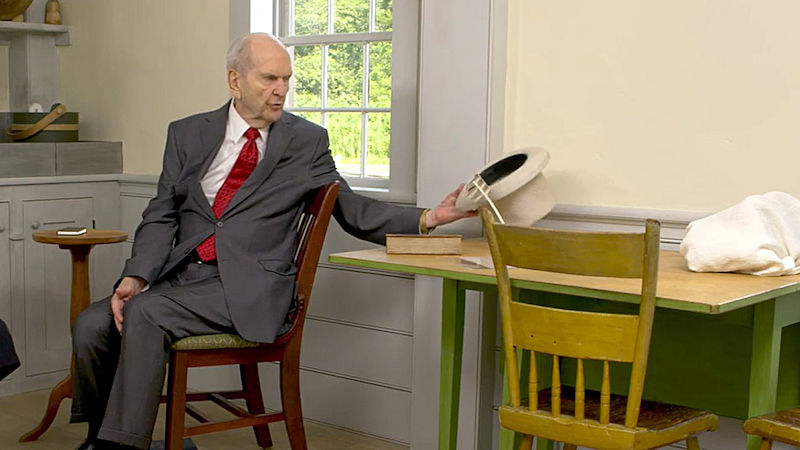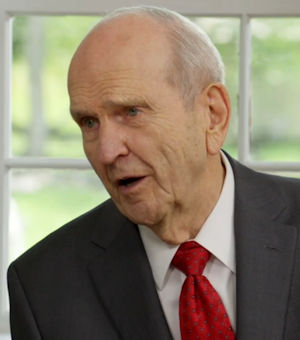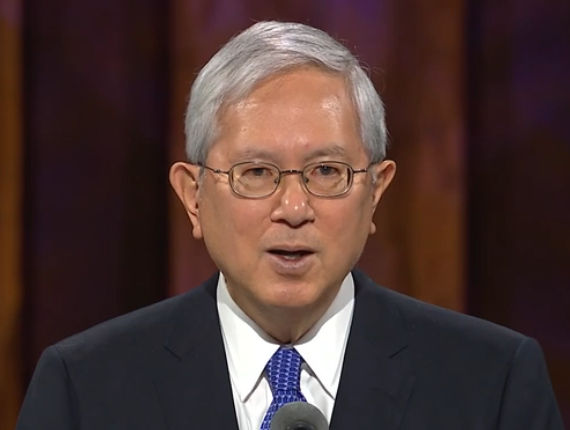It’s becoming more and more difficult for me to tell if Jonathan Neville is being willfully dishonest or if he is simply incapable of grasping the arguments of those with whom he disagrees. His latest post (“
Believing Moroni vs. M2C intellectuals”) so egregiously misrepresents those whom he pejoratively calls “M2C intellectuals”* that it is hard for me to grant him any benefit of the doubt. But I really want to, so I’ll try my best to operate under that paradigm for this post.
Neville begins his post with this claim:
M2C intellectuals are teaching our youth that Moroni was wrong about important aspects of the restoration.
Does he actually cite a single source from an “M2C intellectual” to support this claim?
Of course he doesn’t. Instead, as expected, he repackages his same old threadbare, dishonest, anti-“M2C” arguments that have been refuted again and again by me, Peter Pan, and other researchers.
But it isn’t just that Neville is spinning the same nonsense for which he’s become infamous; in this post, he takes the nonsense to an entirely new level of conspiratorial lunacy. For example, speaking of Mary Whitmer’s encounter with a heavenly messenger, Neville writes:
Moroni was not a portly old man with a long beard, less than six feet tall, the way David Whitmer and his mother Mary described the messenger who took the Harmony plates to Cumorah and brought the plates of Nephi to Fayette. According to Joseph Smith, that was one of the Nephites. According to Mary Whitmer, he called himself brother Nephi.
But according to Book of Mormon Central, the Saints book, and our other M2C intellectuals, the messenger was a shape-shifting Moroni. Book of Mormon Central commissioned this painting and actually titled it "Mary Whitmer and Moroni."
They teach that this old man was Moroni because they don’t want people to know that the Hill Cumorah is in western New York.
Let’s unpack this first before pointing out just how nonsensical Neville’s conclusion is.
First, Neville characterizes the view of “M2C intellectuals” as believing “the messenger was a shape-shifting Moroni.” Have any “M2C intellectuals” actually used term “shape-shifting,” or anything like it, to refer to the angel? Neither
the Book of Mormon Central link nor
the Saints book that Neville cites say anything like that. It’s just Neville’s derisive straw-man caricature.
Second, Neville’s conclusion—“They teach that this old man was Moroni because they don’t want people to know that the Hill Cumorah is in western New York.”—is monstrously absurd. I challenge him to show a
single “M2C intellectual” who has stated, or even
hinted, that the ultimate significance of Mary Whitmer’s encounter with the angel (whomever he was) was that it shows the Hill Cumorah was in Central America.
Just one reference, any reference, will do. The Book of Mormon Central KnoWhy on this topic says absolutely
nothing about the location of the Hill Cumorah. Neither does
Saints. So where on earth, besides his fervent imagination, is Neville coming up with this?
Neville doesn’t stop there, however. He ups the ante by claiming, “To promote M2C, these intellectuals want people to disbelieve Oliver Cowdery, David Whitmer, Joseph Smith, and even Mary Whitmer. As well as Moroni himself.”
That’s a pretty bold claim. Let’s see how it holds up by looking at Neville’s chart putting “the teachings of Moroni” and “the teachings of the M2C intellectuals and revisionist Church historians” side-by-side for comparison.
What, exactly, does Neville mean when he says “LDS intellectuals” claim Joseph “didn’t use the plates”? It would be nice if Neville would perhaps actually quote an “LDS intellectual” or two so that we could hear it from the source and not have to rely on Neville’s jaundiced retelling.
In fact, here’s what two “LDS intellectuals” have said about the significance of the plates:
So, what was the purpose of having the plates if Joseph left them covered during the translation? Though Emma [and other witnesses] explained that Joseph did not use the plates, as a traditional translator would have, they were still deeply important to the translation. They represented where the words originated—demonstrating their historicity, and forming a sense of reality about the individuals described in the Book of Mormon. The plates were in essence the body for the spiritual words that fell from Joseph Smith’s lips as he translated. They created confidence in the minds of Joseph and his family and friends. They offered believers something physical and tangible to understand how and where the text of the Book of Mormon originated.
They were also invaluable for demonstrating that Joseph Smith was a chosen seer. The relationship between the plates, Joseph, and God was indelible for communicating the nature and purpose of the Book of Mormon. Without the plates, the translation was empty, and without Joseph’s gift, it was not from God.
(Michael Hubbard MacKay and Gerrit J. Dirkmaat, From Darkness unto Light: Joseph Smith’s Translation and Publication of the Book of Mormon [Provo: Religious Studies Center, Brigham Young University, 2015], 87–88; emphasis added.)
I think this citation (and its authors) speaks for itself in refuting Neville’s dishonest reporting.
This is another of Neville’s misrepresentations. “LDS intellectuals” have never said Joseph
didn’t use the Nephite interpreters (later called “Urim and Thummim”), the two stones set in silver wire rims and found with the plates, but rather that he didn’t use them
exclusively. There is
abundant historical documentation for Joseph using
both the Urim and Thummim and his personal seer stone in the translation of the Book of Mormon; for example,
here is what the Gospel Topics essay, written by “intellectuals” and endorsed by the First Presidency and the Quorum of the Twelve has to say about this:
Joseph Smith and his scribes wrote of two instruments used in translating the Book of Mormon. According to witnesses of the translation, when Joseph looked into the instruments, the words of scripture appeared in English. One instrument, called in the Book of Mormon the “interpreters,” is better known to Latter-day Saints today as the “Urim and Thummim.” Joseph found the interpreters buried in the hill with the plates. Those who saw the interpreters described them as a clear pair of stones bound together with a metal rim. The Book of Mormon referred to this instrument, together with its breastplate, as a device “kept and preserved by the hand of the Lord” and “handed down from generation to generation, for the purpose of interpreting languages.”
The other instrument, which Joseph Smith discovered in the ground years before he retrieved the gold plates, was a small oval stone, or “seer stone.” As a young man during the 1820s, Joseph Smith, like others in his day, used a seer stone to look for lost objects and buried treasure. As Joseph grew to understand his prophetic calling, he learned that he could use this stone for the higher purpose of translating scripture.
Apparently for convenience, Joseph often translated with the single seer stone rather than the two stones bound together to form the interpreters. These two instruments—the interpreters and the seer stone—were apparently interchangeable and worked in much the same way such that, in the course of time, Joseph Smith and his associates often used the term “Urim and Thummim” to refer to the single stone as well as the interpreters.… Latter-day Saints later understood the term “Urim and Thummim” to refer exclusively to the interpreters. Joseph Smith and others, however, seem to have understood the term more as a descriptive category of instruments for obtaining divine revelations and less as the name of a specific instrument.
Neville has again chosen to either ignore or purposefully misrepresent what these “intellectuals” actually believe and claim.
See above.
See above.
See above. Neville’s
ad nauseam use of this dishonest talking point has become, to say the least, rather tedious.
This is a popular argument used by advocates for the Heartland hoax that
Stephen Smoot has completely refuted. It further misrepresents what “M2C intellectuals” have said about Native American ancestry
relative to Book of Mormon claims.
Without citing any “LDS intellectuals” who actually make this explicit point, Neville has done nothing but make a straw-man assertion.
The wording of this passage is ambiguous; it could be read in at least two different ways: “Written and deposited not far from that place” could mean that the Book of Mormon was both written
and deposited in upstate New York (Neville’s reading) or it could mean it was “written [somewhere else] and [then] deposited” in upstate New York, indicating a temporal progression of events. Neville, of course, takes his reading for granted, but that’s because he isn’t a careful historian doing source criticism; he’s a partisan who is bent on proving his interpretation is the only correct one.
{
Sigh.} Again, this is not what the “intellectuals” have actually argued. In addition to the quote from MacKay and Dirkmaat, above, consider this one:
With Joseph looking into the hat at the seer stones, what need was there for Joseph to even have the plates in his possession? While most of the Book of Mormon translation accounts say little in this regard, the plates may well have served several purposes. Their mere existence may have instilled in Joseph with confidence that the words that appeared on the stones were from an ancient record. In the face of persistent pestering, carrying and possessing the plates would have sustained his confidence that the translation process was authentic. His mission was to “translate the engravings which are on the plates” (D&C 10:41), and he spent some time scrutinizing and transcribing some of the characters on them. Yet the translation usually occurred while the plates lay covered on the table (although some accounts suggest that the plates were sometimes kept in a nearby box under the bed or even hidden in the Whitmers’ barn during translation). In addition, the plates encouraged belief in the minds of needed supporters, such as Emma, the Whitmer family, and the Three and the Eight Witnesses, each of whom spoke of having various experiences touching, hefting, feeling, and seeing the plates. The text of the Book of Mormon is abnormally self-aware of the plates; it focuses again and again on the provenance of and the sources by which Mormon and Moroni compiled the gold plates. It essentially tracks the gold plates and their source material from person to person until the plates end up in the hands of Joseph Smith. The Book of Mormon even prophecies of Joseph’s possession and translation of the record. Therefore, the physical plates fulfill thousands of years of preparation, and the witnesses provide authentication of the historicity of the plates. The plates were therefore indispensable for validating the ancient nature of the Book of Mormon.
(Michael Hubbard MacKay and Gerrit J. Dirkmaat, “Firsthand Witness Accounts of the Translation Process,” in The Coming Forth of the Book of Mormon: A Marvelous Work and a Wonder, ed. Dennis L. Largey, et al. [Provo: Religious Studies Center at Brigham Young University, 2015], 71–72.)
Can Neville’s dishonesty be any more obvious by this point?
There are two things to say about this:
First,
The Autobiography of Parley P. Pratt is a classic of Latter-day Saint literature, and has been rightly enjoyed by scores of Latter-day Saints since its publication in 1874. But Parley P. Pratt died in 1857, so how is it that his autobiography was published nearly twenty years after his death?
Pratt began the book in the mid-1850s, drawing extensively from his personal papers and past publications, but it was not completed by the time of his death and it fell to his son (Parley Jr) and apostle John Taylor to prepare the manuscript for publication. However, “because [the] manuscript has not survived, it is not clear to what extent Taylor and Parley Jr edited the autobiography, particularly the pre-1851 section.” We know from surviving sources that Parley Jr in particular had no qualms about freely revising the text as he pleased, including in its factual details. For example,
To prepare the autobiography for publication, Parley Jr copied his father’s journals into a document known as the “After Manuscript.” This document was then edited. In general, the editing excised passages from Parley’s journal and letters about his family, whether they were positive or negative; also omitted were references to financial difficulties and controversial events. Parley Jr was also conscious of his own image. Parley Sr’s journal for August 18, 1855, notes that Parley Jr met him riding on a mule. In the “After Manuscript,” Parley Jr crossed out “mule” and inserted “horseback.” Eventually, the entire episode was cut from the autobiography.
(Matthew J. Grow, “A ‘Truly Eventful Life’: Writing the Autobiography of Parley P. Pratt,” Journal of Mormon History 37, no. 1 [Winter 2011]: 156–57.)
Such editorial practices were completely normal and accepted in the nineteenth century, before the current standards of professional documentary editing and preservation became the norm. This is not to say Parley Jr was deceitful or dishonest in how he prepared his father’s text; rather, it shows that you cannot uncritically rely on Parley Sr’s autobiography as if it somehow preserves some pristine view of the past without any potential human interpolation. Real historians such as Matthew Grow understand this; Neville obviously does not.
Second, consider what this source is actually preserving. Beginning on
page 57 of the first 1874 edition, it quotes Oliver Cowdery verbatim for three whole pages in a speech to the Indians of the Delaware nation. Remember, this speech was reportedly made in the winter of 1830/1831, during the
Lamanite Mission. By the time Pratt committed this account to writing in the mid-1850s, over
twenty years had passed. Not only that, but it’s explicitly third-hand hearsay:
This Book [of Mormon], which contained these things, was hid in the earth by Moroni, in a hill called by him, Cumorah, which hill is now in the State of New York, near the village of Palmyra, in Ontario county.
So, twenty years after the fact, Parley P. Pratt transcribed what Oliver Cowdery had said what the angel Moroni told “him.” Is the
him Cowdery? Or was it Joseph Smith, who
then told Cowdery—making this a
fourth-hand source? The text doesn’t say where Cowdery got this information. And that’s the point of why real historians like Grow urge caution in not blindly accepting late, third-hand recollections as unquestionable truth but rather as pieces of individual evidence that need to be properly weighed and balanced with other sources.
Now you can perhaps understand why I began this post by saying it is honestly hard for me to tell if Jonathan Neville is being willfully dishonest or if he is simply incapable of grasping the arguments of those with whom he disagrees.
—Captain Hook
* “M2C” is Jonathan Neville’s acronym for the theory that the Book of Mormon took place in Mesoamerica and that the hill Cumorah in the Book of Mormon is not the same hill in New York where Joseph Smith received the plates of Mormon.
 After this, President Nelson compared Joseph’s use of the stones in a hat to President Nelson’s use of a mobile phone to receive messages that only he can see. (President Dieter F. Uchtdorf,
After this, President Nelson compared Joseph’s use of the stones in a hat to President Nelson’s use of a mobile phone to receive messages that only he can see. (President Dieter F. Uchtdorf, 



















